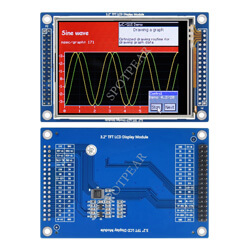- sales/support
Google Chat: zj734465502@gmail.com
- sales
+86-0755-88291180
- sales01
sales@spotpear.com
- sales02
dragon_manager@163.com
- support
tech-support@spotpear.com
- CEO-Complaints
zhoujie@spotpear.com
- sales/support
WhatsApp:13246739196
- HOME
- >
- ARTICLES
- >
- Common Moudle
- >
- LCD
3.2inch 320x240 Touch LCD (D) User Guide
1. Hardware Resources
1.1 ILI9341
- ILI9341 is a 262144-color TFT LCD driver chip with a resolution of 240x320 (RGB) and 172820 (240 x 320x 18/8) bytes of RAM. Each pixel depth can reach 18 bits.
- ILI9341 has the following data interface modes:
1) i80-system MPU port (8-/9-/16-/18-bit bus width).
2) serial data transfer port (SPI).
3) RGB 6-/16-/18-bit port (DOTCLK, VSYNC, HSYNC, ENABLE, DB[17:0]).
The corresponding relationship between the 18-bit RGB assignment of ILI9341 and LCD GRAM in this screen is shown in the figure: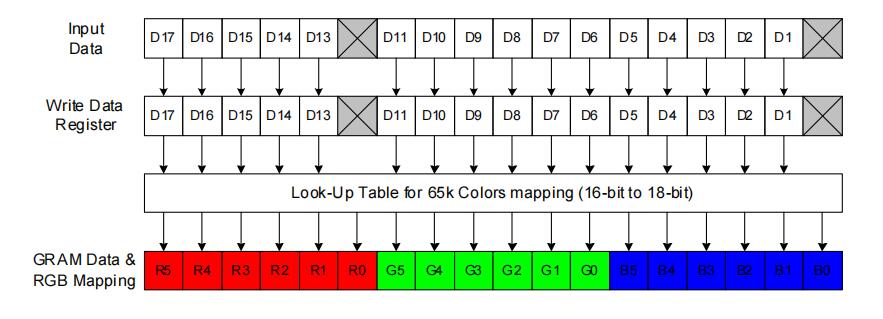
According to the above figure, ILI9341 is in the 16-bit mode and the available GRAM data are D17~D13 and D11~D1. D12 and D0 are not used. Actually, D12 and D0 of ILI9341 are not adapted in our LCD module. D17~D13 and D11~D1 of ILI9341 correspond to D15~D0 of MCU. In the 16-bit data of the MCU, the lowest 5 bits represent blue, the middle 6 bits are green, and the highest 5 bits are red. The larger the value, the darker the color.
8080 16-bit Interface Sequence Introduction
- For more details about the register, please refer to ILI9341.pdf.
- Here we only introduce the sequence requirements for reading and writing.
The 8080 interface is designed by Intel. It is a parallel, asynchronous, half-duplex communication protocol. It is used for external expansion of RAM and ROM and is also used for LCD interface later.
- Four control cables
RD: Write enable (write information to register) WR: read enable (read information from the register) DC(RS): data/command (1 for reading and writing data, 0 for reading and writing commands) CS: chip select
- The sequence diagram for writing commands or data is as follows:
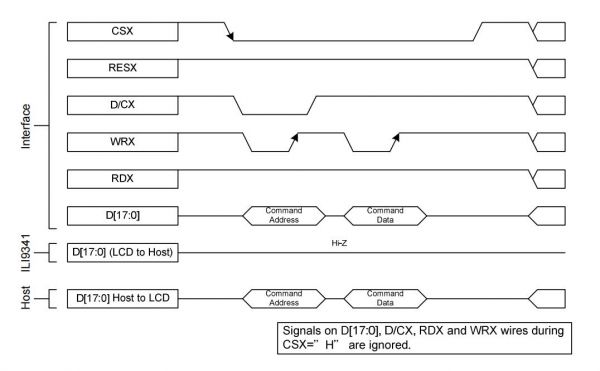
- The sequence diagram for reading information is as follows:
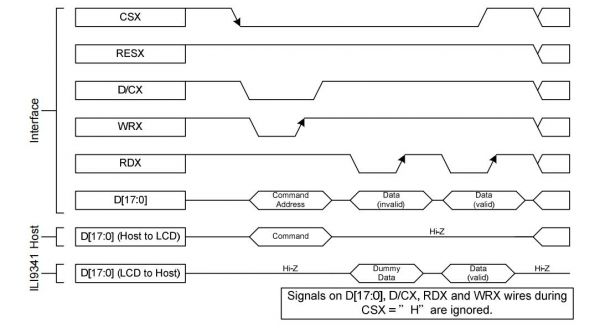
1.2 XPT2046
- The XPT2046 is a 4-wire resistive touchscreen controller with a successive approximation A/D converter with 12-bit resolution and a conversion rate of 125KHZ.
- The XPT2046 supports low-voltage I/O interfaces from 1.5V to 5.25V.
- The XPT2046 can detect the touched position on the screen by performing two A/D conversions, in addition to measuring the pressure applied on the touch screen. The built-in 2.5V reference voltage can be used as an auxiliary input, temperature measurement, and battery monitoring. The voltage range of battery monitoring can be from 0V to 5V.
- The XPT2046 has a temperature sensor integrated on-chip. Under typical operating conditions of 2.7V, with the reference voltage off, the power consumption can be less than 0.75mW. The XPT2046 is available in tiny packages: TSSOP-16, QFN-16, and VFBGA-48. The working temperature range is -40℃~+85℃. Fully compatible with ADS7846, TSC2046, and AK4182A.
2. Hardware Description
| Pin No. | Symbol | Description | Function |
| 1 | 5V | 5V power supply | When powered from 5V supply, pin 1 & Pin 2 as power input, pin 33 & Pin 34 provide 3.3V output. |
| 2 | GND | Ground | GND |
| 3 | D0 | Data cable | D0-D15 |
| 4 | D1 | ||
| 5 | D2 | ||
| 6 | D3 | ||
| 7 | D4 | ||
| 8 | D5 | ||
| 9 | D6 | ||
| 10 | D7 | ||
| 11 | D8 | ||
| 12 | D9 | ||
| 13 | D10 | ||
| 14 | D11 | ||
| 15 | D12 | ||
| 16 | D13 | ||
| 17 | D14 | ||
| 18 | D15 | ||
| 19 | CS | LCD chip selection signal | Low active |
| 20 | RS | Command/Data Register Selection | RS = 0: Command Register RS = 1: Data Register |
| 21 | WR | Write | WR = 0, RD = 1 |
| 22 | RD | Read | WR = 1, RD = 0 |
| 23 | RESET | Reset the controller chip | Low active |
| 24 | NC | Not connect | Not connect |
| 25 | BLVCC | 5V or 3.3V | Backlight VCC |
| 26 | BLGND | Ground | Backlight GND |
| 27 | BLCNT | Backlight brightness adjustment | Control the backlight brightness via PWM |
| 28 | TP_IRQ | Touch panel interrupt | Low level while the touch panel detects pressing |
| 29 | TP_CS | Touch panel chip select | Low active |
| 30 | TP_SCK | Touch panel SPI clock | Connects to SPI SCK |
| 31 | TP_SI | Touch panel data input | Connects to SPI MOSI |
| 32 | TP_SO | Touch panel SPI data output | Connects to SPI MISO |
| 33 | 3.3V | 3.3V power supply | When powered from 3.3V supply, pin 33 & pin 34 as power input, pin 1 & pin 2 keep NC. |
| 34 | GND | Ground |
3. Sample Demo
This manual uses the development board of the main control chip STM32F103RCT6 to illustrate the basic usage of this LCD. Users can also use other similar development boards for development.
3.2inch 320x240 Touch LCD (D) and STM32F103RCT6 connection interface diagram: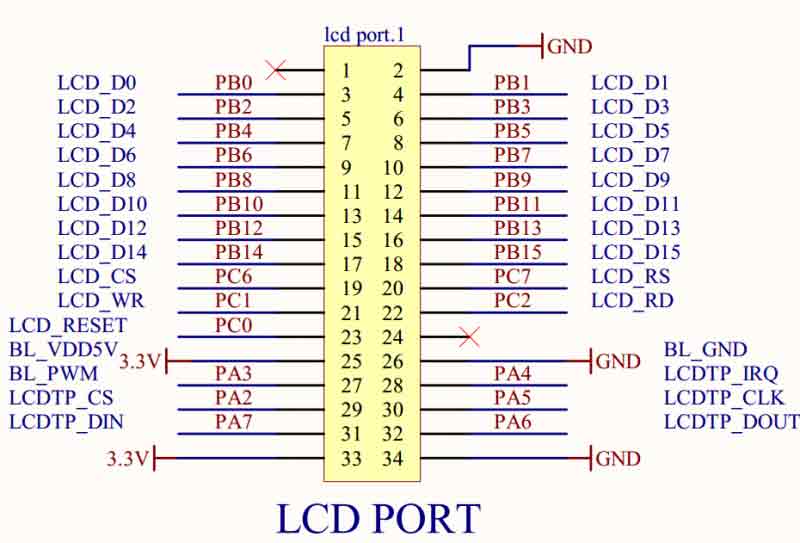
Procedure flow chart: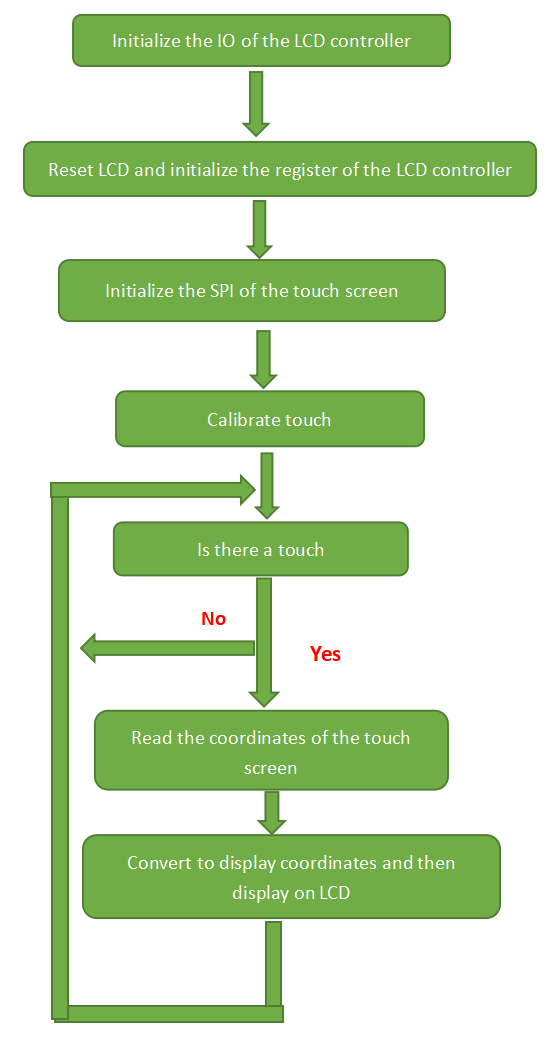
Source code analysis:
/*The following macro definition is for the rotation angle of the image and the setting of the control cable*/<br />
//#define DISP_ORIENTATION 0
//#define DISP_ORIENTATION 90
//#define DISP_ORIENTATION 180
#define DISP_ORIENTATION 270
#define Set_Cs GPIOC->BSRR = GPIO_Pin_6 //CS=1
#define Clr_Cs GPIOC->BRR = GPIO_Pin_6 //CS=0
#define Set_Rs GPIOC->BSRR = GPIO_Pin_7 //RS=1
#define Clr_Rs GPIOC->BRR = GPIO_Pin_7 //RS=0
#define Set_nWr GPIOC->BSRR = GPIO_Pin_1 //WR=1
#define Clr_nWr GPIOC->BRR = GPIO_Pin_1 //WR=0
#define Set_nRd GPIOC->BSRR = GPIO_Pin_2 //RD=1
#define Clr_nRd GPIOC->BRR = GPIO_Pin_2 //RD=0
/* Write command function */
__inline void LCD_WriteIndex(uint16_t index)
{
Clr_Rs; //RS=0
Set_nRd; //RD=0
LCD_Delay(0); //Delay
GPIOB->ODR = index; /*Write command */
LCD_Delay(0); //Delay
Clr_nWr; //WR=0
Set_nWr; //WR=1
}
/* */
__inline void ILI9341_LCD_WriteData(uint16_t data)
{
Clr_Cs; //CS=1
Set_Rs; //RS=1
LCD_Delay(0); //delay
GPIOB->ODR = data; /* GPIO_Write(GPIOB,data); */
LCD_Delay(0); //delay
Clr_nWr; //WR=0
Set_nWr; //WR=1
Set_Cs; //CS=1
}
/* Read data function */
__inline uint16_t LCD_ReadData(void)
{
uint16_t value;
Set_Rs;
Set_nWr;
Clr_nRd;
GPIOB->CRH = 0x44444444; //Set PB0-PB15 as input
GPIOB->CRL = 0x44444444;
value = GPIOB->IDR; //Read data
GPIOB->CRH = 0x33333333; //Set PB0-PB15 as output
GPIOB->CRL = 0x33333333;
Set_nRd;
return value;
}
/******************************************************************************
Write data at the specified address, LCD_Reg is the address, and LCD_RegValue is the written value.
******************************************************************************/
__inline void LCD_WriteReg(uint16_t LCD_Reg,uint16_t LCD_RegValue)
{
Clr_Cs;
LCD_WriteIndex(LCD_Reg); //Write command; that is, the address to write data into;
LCD_WriteData(LCD_RegValue); //data writing;
Set_Cs;
}
/******************************************************************************
Read data from the specified address, LCD_Reg is the address, and the function returns the read value.
<pre>
******************************************************************************/
__inline uint16_t LCD_ReadReg(uint16_t LCD_Reg)
{
uint16_t LCD_RAM;
Clr_Cs;
LCD_WriteIndex(LCD_Reg); //Write command; that is, the address of the data to be read;
LCD_RAM = LCD_ReadData(); //data readout;
Set_Cs;
return LCD_RAM;
}
//The above are the basic functions for reading and writing; if you want to operate IO analog with the FSMC of the STM32, you can refer to LCD + TouchPanel (8080 FSMC) demo.
/******************************************************************************
Initialization of LCD registers, the following initialization values of the registers are provided by the original LCD manufacturer and can be displayed normally according to the following configuration, please refer to the chip manual for registers.
******************************************************************************/
void LCD_Initializtion(void)
{
uint16_t DeviceCode;
LCD_Configuration(); //Pin initialization
GPIO_PinRemapConfig(GPIO_Remap_SWJ_JTAGDisable , ENABLE);//Change the mapping of the specified pin
GPIO_ResetBits(GPIOC, GPIO_Pin_0); /* LCD reset*/
delay_ms(100);
GPIO_SetBits(GPIOC, GPIO_Pin_0);
GPIO_SetBits(GPIOA, GPIO_Pin_3); /*Enable backlight */
DeviceCode = LCD_ReadReg(0x0000); /* Read ID */
if(DeviceCode == 0 || DeviceCode == 0xffff)
{
ILI9341_LCD_WriteReg(0XD3);
Clr_Cs;
DeviceCode = LCD_ReadData();
DeviceCode = LCD_ReadData();
DeviceCode = LCD_ReadData();
DeviceCode <<= 8;
DeviceCode |= LCD_ReadData();
Set_Cs;
}
if(DeviceCode == 0x9341)
{
LCD_Code = ILI9341;
ILI9341_LCD_WriteReg(0x3A);
ILI9341_LCD_WriteData(0x55);
ILI9341_LCD_WriteReg(0xB5);
ILI9341_LCD_WriteData(0X04);
ILI9341_LCD_WriteData(0X04);
ILI9341_LCD_WriteData(0X0A);
ILI9341_LCD_WriteData(0x14);
ILI9341_LCD_WriteReg(0x35);
ILI9341_LCD_WriteData(0x00);
ILI9341_LCD_WriteReg(0xCF);
ILI9341_LCD_WriteData(0x00);
ILI9341_LCD_WriteData(0xEA);
ILI9341_LCD_WriteData(0XF0);
ILI9341_LCD_WriteReg(0xED);
ILI9341_LCD_WriteData(0x64);
ILI9341_LCD_WriteData(0x03);
ILI9341_LCD_WriteData(0X12);
ILI9341_LCD_WriteData(0X81);
ILI9341_LCD_WriteReg(0xE8);
ILI9341_LCD_WriteData(0x85);
ILI9341_LCD_WriteData(0x10);
ILI9341_LCD_WriteData(0x78);
ILI9341_LCD_WriteReg(0xCB);
ILI9341_LCD_WriteData(0x39);
ILI9341_LCD_WriteData(0x2C);
ILI9341_LCD_WriteData(0x00);
ILI9341_LCD_WriteData(0x33);
ILI9341_LCD_WriteData(0x06);
ILI9341_LCD_WriteReg(0xF7);
ILI9341_LCD_WriteData(0x20);
ILI9341_LCD_WriteReg(0xEA);
ILI9341_LCD_WriteData(0x00);
ILI9341_LCD_WriteData(0x00);
ILI9341_LCD_WriteReg(0xC0); //Power control
ILI9341_LCD_WriteData(0x21); //VRH[5:0]
ILI9341_LCD_WriteReg(0xC1); //Power control
ILI9341_LCD_WriteData(0x10); //SAP[2:0];BT[3:0]
ILI9341_LCD_WriteReg(0xC5); //VCM control
ILI9341_LCD_WriteData(0x4F); //3F
ILI9341_LCD_WriteData(0x38); //3C
ILI9341_LCD_WriteReg(0xC7); //VCM control2
ILI9341_LCD_WriteData(0XB7);
ILI9341_LCD_WriteReg(0x36); // Memory Access Control
if (DISP_ORIENTATION == 0)
ILI9341_LCD_WriteData(0x08 | 0x00);
else if (DISP_ORIENTATION == 90)
ILI9341_LCD_WriteData(0x08 | 0xa0);
else if(DISP_ORIENTATION == 180)
ILI9341_LCD_WriteData(0x08 | 0xc0);
else
ILI9341_LCD_WriteData(0x08 | 0x60);
ILI9341_LCD_WriteReg(0xB1);
ILI9341_LCD_WriteData(0x00);
ILI9341_LCD_WriteData(0x13);
ILI9341_LCD_WriteReg(0xB6); // Display Function Control
ILI9341_LCD_WriteData(0x0A);
ILI9341_LCD_WriteData(0xA2);
ILI9341_LCD_WriteReg(0xF2); // 3Gamma Function Disable
ILI9341_LCD_WriteData(0x02);
ILI9341_LCD_WriteReg(0x26); //Gamma curve selected
ILI9341_LCD_WriteData(0x01);
ILI9341_LCD_WriteReg(0xE0); //Set Gamma
ILI9341_LCD_WriteData(0x0F);
ILI9341_LCD_WriteData(0x27);
ILI9341_LCD_WriteData(0x24);
ILI9341_LCD_WriteData(0x0C);
ILI9341_LCD_WriteData(0x10);
ILI9341_LCD_WriteData(0x08);
ILI9341_LCD_WriteData(0x55);
ILI9341_LCD_WriteData(0X87);
ILI9341_LCD_WriteData(0x45);
ILI9341_LCD_WriteData(0x08);
ILI9341_LCD_WriteData(0x14);
ILI9341_LCD_WriteData(0x07);
ILI9341_LCD_WriteData(0x13);
ILI9341_LCD_WriteData(0x08);
ILI9341_LCD_WriteData(0x00);
ILI9341_LCD_WriteReg(0XE1); //Set Gamma
ILI9341_LCD_WriteData(0x00);
ILI9341_LCD_WriteData(0x0F);
ILI9341_LCD_WriteData(0x12);
ILI9341_LCD_WriteData(0x05);
ILI9341_LCD_WriteData(0x11);
ILI9341_LCD_WriteData(0x06);
ILI9341_LCD_WriteData(0x25);
ILI9341_LCD_WriteData(0x34);
ILI9341_LCD_WriteData(0x37);
ILI9341_LCD_WriteData(0x01);
ILI9341_LCD_WriteData(0x08);
ILI9341_LCD_WriteData(0x07);
ILI9341_LCD_WriteData(0x2B);
ILI9341_LCD_WriteData(0x34);
ILI9341_LCD_WriteData(0x0F);
ILI9341_LCD_WriteReg(0x11); //Exit Sleep
delay_ms(120);
ILI9341_LCD_WriteReg(0x29); //Display on
}
delay_ms(50);
}
/******************************************************************************
Set the positions X, and Y of the display window;
*****************************************************************************/
void LCD_Address_Set(u16 x1,u16 y1,u16 x2,u16 y2)
{
ILI9341_LCD_WriteReg(0x2a);//Column address setting
ILI9341_LCD_WriteData(x1>>8);
ILI9341_LCD_WriteData(x1&0xff);
ILI9341_LCD_WriteData(x2>>8);
ILI9341_LCD_WriteData(x2&0xff);
ILI9341_LCD_WriteReg(0x2b);//Line address setting
ILI9341_LCD_WriteData(y1>>8);
ILI9341_LCD_WriteData(y1&0xff);
ILI9341_LCD_WriteData(y2>>8);
ILI9341_LCD_WriteData(y2&0xff);
ILI9341_LCD_WriteReg(0x2c);//Write in memory
}
static void LCD_SetCursor( uint16_t Xpos, uint16_t Ypos )
{
uint16_t temp;
#if (DISP_ORIENTATION == 0)
#elif (DISP_ORIENTATION == 90)
temp = Xpos;
Xpos =Ypos;
Ypos = MAX_X - 1 - temp;
#elif (DISP_ORIENTATION == 180)
Xpos = MAX_X - 1 - Xpos;
Ypos = MAX_Y - 1 - Ypos;
#elif (DISP_ORIENTATION == 270)
temp = Ypos;
Ypos = Xpos;
Xpos = MAX_Y - 1 - temp;
#endif
ILI9341_LCD_WriteReg(0x2a); //Column address setting
ILI9341_LCD_WriteData(Xpos>>8);
ILI9341_LCD_WriteData(Xpos&0xff);
ILI9341_LCD_WriteReg(0x2b); //Line address setting
ILI9341_LCD_WriteData(Ypos>>8);
ILI9341_LCD_WriteData(Ypos&0xff);
}
/******************************************************************************
Clearing screen function to make the whole screen display a certain color,
*****************************************************************************/
void LCD_Clear(uint16_t Color)
{
uint32_t index=0;
LCD_Address_Set(0,0,MAX_X-1,MAX_Y-1);//Set the display range
for( index = 0; index < MAX_X * MAX_Y; index++ )
{
ILI9341_LCD_WriteData(Color);
}
}
int main(void)
{
//Delay and initialization system
LCD_Initializtion(); //LCD initialization
//LCD initialization
LCD_Clear(Red); //Clear the screen to red
//You can write a function to calibrate the screen.
/* Infinite loop */
while (1)
{
//You can write a function to display the coordinates of the touch point on the LCD.
}
} 



